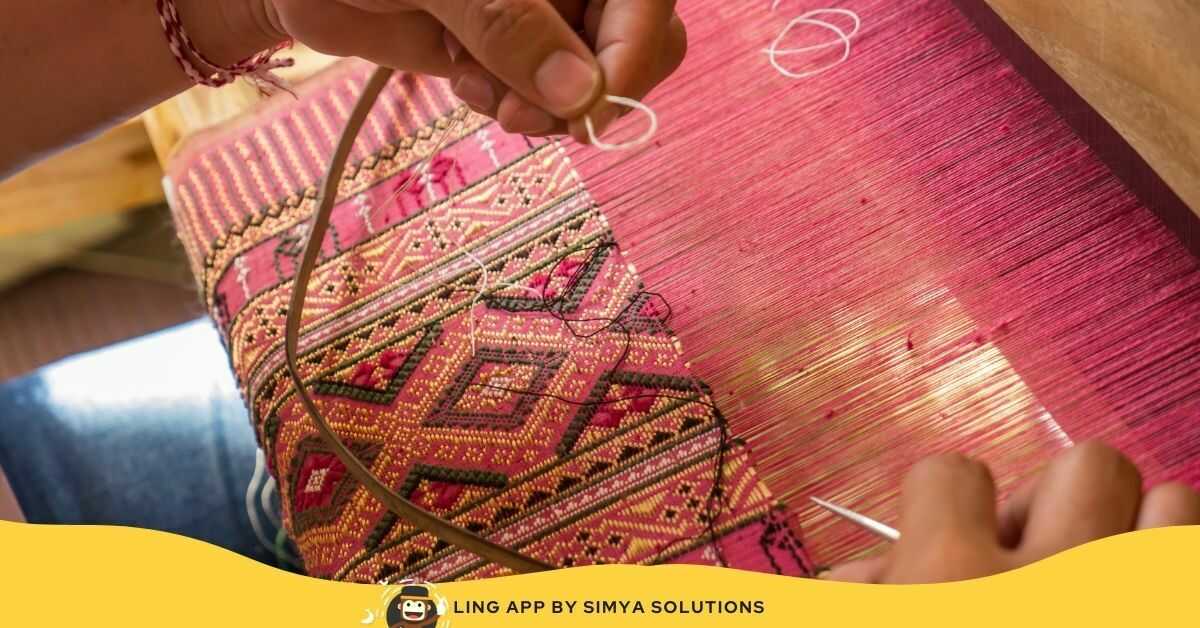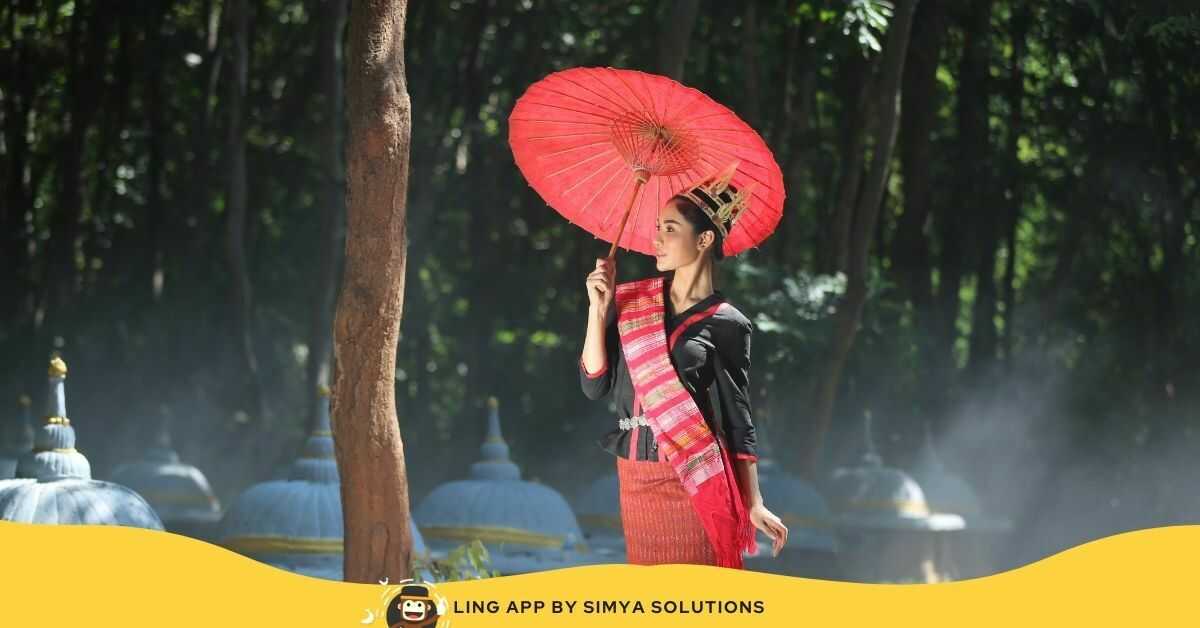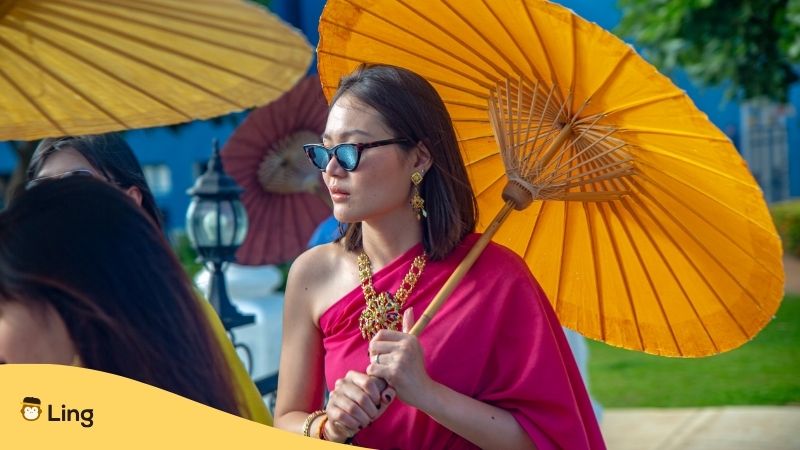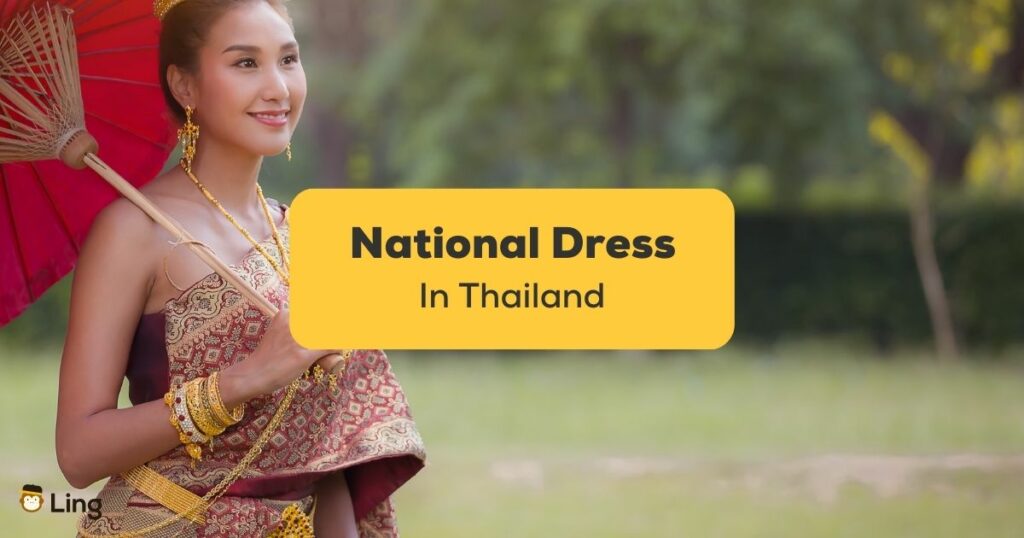Interested in joining a formal occasion or a national festival in the Land of Smiles? The traditional Thai clothing is not just a garment but an instantly recognizable reflection of Thailand and its people. If you are ever lucky enough to visit this part of Southeast Asia, be sure to check out the local mall. There is bound to be a boutique where, for a handful of baht, you can get decked out in traditional Thai dress for a beautiful photo you and your loved ones will treasure forever.
Best known as ชุดไทย or Chut Thai, Traditional Thai clothing is the type of outfit that you can use to blend in well with the crowd. It is a unique type of traditional dress from Southeast Asia that anyone can wear and is mainly considered the official national costume. What makes it unique is that it incorporates Victorian fashion, but it also reveals much about the country’s identity, beliefs, and way of living. Let’s get to know more about this today!
When it comes to traditional outfits, every country has its own designs, which are all developed based on the current circumstances and trends when it was first created. Throughout the years, the designs are shifting too, and this is the reason many countries have more than just one type of traditional clothing. In fact, there are also those who just have too many designs that they end up not proclaiming a national dress for their country.
So, let’s take a closer look at the elegance and significance of the Thai traditional dress and the various styles that have graced Thai society for centuries.
History Of The Thai Clothing

The history of the Thai dress, or ชุดไทย (chut thai), goes back a number of centuries to the time of the Sukhothai Kingdom (1238-1438) and the Ayutthaya Kingdom (1350-1767).
During these periods, clothing that reflected social status was made to be worn by men, women, and children – both boys and girls. Males typically wore pants, or “pha chung hang” (ผ้าจูงหาง), an expensive Raj pattern shirt, optional white long-socks pulled up to the knee, and a shawl-like garment called a “sabai” (สไบ). Women tended to wear traditional dresses, or “pha nung” (ผ้านุ่ง).
The traditional costume reflects its history and how it adopted trends from its neighboring countries. For instance, there was a time wherein the Thai people wore Chong Kben or a collarless blouse with a wrap-around type of cloth that Cambodia popularized.
Usually, it is normal to show bare feet and bare chest and wear gold jewelry or metal belts. There was also the Sinh or Pha Sinh which is a shawl-like garment wrapped around the waist and is worn with a national hairstyle for women.
When 1960 came, the royals of Thailand were alarmed when they realized that the country did not really have a specific traditional Thai dress that could be worn for royal ceremonies and other formal occasions. Queen Sirikit (Queen mother of Thailand and the wife of the late King Bhumibol Adulyadej) worked with royal tailors, historians, and French designers to come up with a range of traditional Thai dresses that the country could be proud of. The designs were based on several factors and not only on trendiness. In fact, the stylebook they created solidifies the Thai national identity.
Relevance Of The Traditional Thai Clothing

The traditional dress of Thailand is also known as chut Thai phra ratcha niyom, and it continues to exist even to this day. In fact, you can simply walk the streets of Bangkok, and you will see tons of street shops selling different Chut Thai designs for men, women, and children. And when we say “different” we literally mean that there are lots of styles that you can consider before purchasing one. The reason for this is that every look can make use of different garments, fabrics, accessories, and patterns that are based on the particular event.
For the Thai people, having an official national costume helps in unifying the identity of the country. On top of that, every style shows the traditional weaving technique, imagery from the country, local patterns, and the inherent modesty of the locals.
What Is The Traditional Thai Dress Called?
Chut Thai is a type of traditional outfit best known for its bright and modest look. It is usually made of silk since the country is known for its huge number of silkworms. However, since Cambodia and India have a history, the current designs today still show the use of gold and silver, which were first introduced by the aforesaid countries.
Common Thai Clothing For Women

Listed below are some examples of traditional Thai dresses that you can take note of depending on the occasion:
- Ruean Ton – A casual Thai dress for Thai women who will join religious ceremonies or any non-official functions. It makes use of a tube-like skirt and is partnered with a long-sleeved collarless blouse.
- Chakkri – Elegant traditional Thai costume typically worn for formal and semi-formal functions. It makes use of Sabai, which is used to cover the upper garment and at least one shoulder.
- Siwalai – A formal evening attire that consists of a long tube skirt, a long-sleeved blouse, and a Sabai (a breast cloth that is similar to a luxurious shawl).
- Dusit – This type of Thai traditional dress makes use of a silk dress (ankle length) as an inner instead of the usual round neck and long-sleeved blouses. It is worn with a belt and can be used for semi-formal occasions and festival celebrations.
Common Thai Clothing For Men

Of course, fashion is not just for women. The men can wear any of these traditional Thai dresses:
- Pakama – A piece of fabric worn around the waist and can also double as a towel or head covering when needed.
- Suea Phraratchathan – A jacket with a Mandarin collar partnered with black pants. It can be worn with a blazer for casual occasions or even at school.
Components Of The Thai National Dress
For Men:
Pha Nung (ผ้านุ่ง): The traditional loincloth wrapped around the waist and up between the legs, usually made from cotton, silk, or other local materials. It is tied around the waist and secured with a knot, with the ends hanging down. Pha Nung is one of the traditional Thai garments often worn in royal ceremonies and festivals.
Pha Chung Hang (ผ้าจูงหาง): A wraparound cloth that resembles baggy breeches worn by both men and the fairer sex.
Sabai (สไบ): The sabai is a shawl or sash that is worn diagonally across the chest and jauntily thrown over one shoulder. It is an essential accessory, especially for formal occasions, and is frequently made from silk or other fancy materials.
Suea Phraratchathan (เสื้อพระราชทาน): A modern addition to the traditional Thai dress that literally translates as “royally bestowed shirt.” It has buttons, a long collar, and long sleeves, and is worn on formal evening occasions, often paired with Western-style suit trousers.

For Women:
Pha Sin (ผ้าซิ่น): The sin consists of a long, tube skirt usually made from Thai silk that is wrapped around the waist and secured with a pin. It comes in various colors and patterns, each representing different regions and ethnic groups within Thailand – these traditional Thai dresses are the type you will see in every holiday brochure.
Sabai (สไบ): Women also wear a sabai, frequently draped over one shoulder or worn as a sash. It complements the pha sin and adds grace to the overall look.
Banong (บานง): Women pair the pha sin with a traditional blouse called the banong. These blouses are intricately embroidered and can vary in style depending on the region.
Pha Biang (ผ้าเบี่ยง): The pha biang is a fabric that women wear over the shoulder or as a headscarf, adding a final touch of elegance to their ensemble.
Styles Of The Thai National Dress
Northern Thai Dress: The traditional dress of northern Thailand is characterized by its intricate embroidery and use of indigo-dyed fabrics. Women often wear a long-sleeved blouse and a pha sin (ผ้าซิ่น) adorned with beautiful geometric patterns.
Central Thai Dress: The central region’s dress is known for its simplicity and elegance. Women wear a pha sin (ผ้าซิ่น) with a banong blouse (บานง), while men opt for a pha nung (ผ้านุ่ง) paired with a sabai (สไบ).
Southern Thai Dress: Southern Thai clothing features vibrant colors and intricate patterns. Women wear a sarong-style pha sin (ผ้าซิ่น) with a banong blouse (บานง), while men wear a pha nung (ผ้านุ่ง) with a sabai (สไบ).
Traditional Thai Dance Costume: Thai classical dance forms, such as Khon and Likay, have their own elaborate costumes. These costumes are adorned with intricate jewelry and accessories, creating a mesmerizing visual spectacle during performances.
Modern Influence And Adaptations
While traditional Thai clothing remains an integral part of the culture, it has also evolved to suit contemporary tastes and lifestyles. Modern interpretations of Thai fashion incorporate traditional elements into everyday wear, making it accessible and relevant to people’s lives.
Fashion Designers: Thai fashion designers have gained international recognition for their ability to blend traditional Thai elements with modern designs. This fusion has resulted in stunning creations that are embraced not only in Thailand but also on the global fashion stage.
Casual Wear: Elements of the Thai national dress, such as the use of silk and traditional patterns, have made their way into everyday clothing. The modern Thai outfit often includes silk dresses, blouses, and accessories that pay homage to the country’s heritage.
Global Influence: Thai fashion has influenced the global fashion industry, with designers and brands incorporating Thai-inspired elements into their collections. This has further elevated the profile of Thai fashion on the world stage.
Wrapping Up
As we reach this part of the post, we hope that you were able to learn more about the Chut Thai or ชุดไทย and how unique it looks as compared to other outfits from Southeast Asia. Since it makes use of Thai silk, natural fabrics, and it bears embroidery (with very fine threads of gold and silver) like no other, there is something truly luxurious about the way the country’s traditional outfits look. May it be for formal events or not, you shouldn’t pass up the opportunity to wear one when you visit Thailand!
The good news here is that there are several shops for tourists that allow anyone to rent these beautiful dresses for a very low price. So, if you are interested in experiencing Thailand on a whole new level, we highly recommend that you rent one or purchase some of their modern national outfit. You can also wear it even if you are no longer in the country!
If you enjoyed this post and figured that you would love to learn more about the culture, language, and Thai people, please check out our previous language learning posts, like the common words used to name shapes and identify relationships. But if you feel like you have this intense passion for mastering the Thai language, there’s nothing more that we can recommend than the Ling app.
The Ling app is a language learning platform that seeks to provide you unlimited access to lessons in the Thai language and 60+ other foreign languages. With your account, you can simply get lessons, challenge yourself with the quizzes and fun games, and even develop your confidence through its AI chatbot. The best part here is that you can try it out for free today, and you can start learning every day for at least 10 minutes.
So, what are you waiting for? Install the Ling app today and discover an entertaining way to learn languages.










































